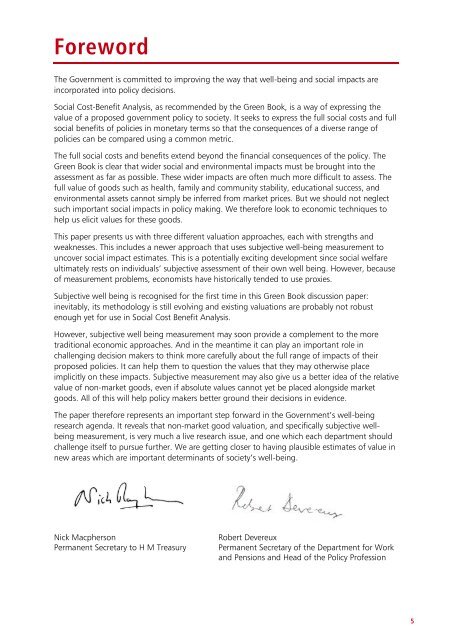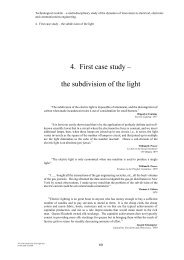Valuation Techniques for Social Cost-Benefit Analysis: - HM Treasury
Valuation Techniques for Social Cost-Benefit Analysis: - HM Treasury
Valuation Techniques for Social Cost-Benefit Analysis: - HM Treasury
Create successful ePaper yourself
Turn your PDF publications into a flip-book with our unique Google optimized e-Paper software.
Foreword<br />
The Government is committed to improving the way that well-being and social impacts are<br />
incorporated into policy decisions.<br />
<strong>Social</strong> <strong>Cost</strong>-<strong>Benefit</strong> <strong>Analysis</strong>, as recommended by the Green Book, is a way of expressing the<br />
value of a proposed government policy to society. It seeks to express the full social costs and full<br />
social benefits of policies in monetary terms so that the consequences of a diverse range of<br />
policies can be compared using a common metric.<br />
The full social costs and benefits extend beyond the financial consequences of the policy. The<br />
Green Book is clear that wider social and environmental impacts must be brought into the<br />
assessment as far as possible. These wider impacts are often much more difficult to assess. The<br />
full value of goods such as health, family and community stability, educational success, and<br />
environmental assets cannot simply be inferred from market prices. But we should not neglect<br />
such important social impacts in policy making. We there<strong>for</strong>e look to economic techniques to<br />
help us elicit values <strong>for</strong> these goods.<br />
This paper presents us with three different valuation approaches, each with strengths and<br />
weaknesses. This includes a newer approach that uses subjective well-being measurement to<br />
uncover social impact estimates. This is a potentially exciting development since social welfare<br />
ultimately rests on individuals‘ subjective assessment of their own well being. However, because<br />
of measurement problems, economists have historically tended to use proxies.<br />
Subjective well being is recognised <strong>for</strong> the first time in this Green Book discussion paper:<br />
inevitably, its methodology is still evolving and existing valuations are probably not robust<br />
enough yet <strong>for</strong> use in <strong>Social</strong> <strong>Cost</strong> <strong>Benefit</strong> <strong>Analysis</strong>.<br />
However, subjective well being measurement may soon provide a complement to the more<br />
traditional economic approaches. And in the meantime it can play an important role in<br />
challenging decision makers to think more carefully about the full range of impacts of their<br />
proposed policies. It can help them to question the values that they may otherwise place<br />
implicitly on these impacts. Subjective measurement may also give us a better idea of the relative<br />
value of non-market goods, even if absolute values cannot yet be placed alongside market<br />
goods. All of this will help policy makers better ground their decisions in evidence.<br />
The paper there<strong>for</strong>e represents an important step <strong>for</strong>ward in the Government‘s well-being<br />
research agenda. It reveals that non-market good valuation, and specifically subjective wellbeing<br />
measurement, is very much a live research issue, and one which each department should<br />
challenge itself to pursue further. We are getting closer to having plausible estimates of value in<br />
new areas which are important determinants of society‘s well-being.<br />
Nick Macpherson Robert Devereux<br />
Permanent Secretary to H M <strong>Treasury</strong> Permanent Secretary of the Department <strong>for</strong> Work<br />
and Pensions and Head of the Policy Profession<br />
5





![AIRTO [Professor Dr Brian Blunden] - HM Treasury](https://img.yumpu.com/15492848/1/184x260/airto-professor-dr-brian-blunden-hm-treasury.jpg?quality=85)










